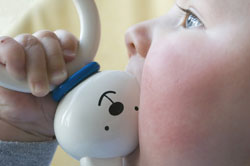The Battle to Ban Toxic Toys
“Phthalates” (pronounced THA-lates) are found in everything from cosmetics to IV bags to children’s toys. Environmentalists and environmentally minded legislators are beginning to worry about long-term exposure to the chemical compounds. Specifically, they worry about diisononyl phthalate or DINP, a plasticizer commonly used in soft vinyl products made for babies, such as bath books, rubber ducks and teething rings as well as bisphenol A (BPA), a building block for polycarbonate plastic used in shatter-resistant baby bottles. Studies have linked BPA to hormone disruption in rats, to increased breast cancer and prostate cancer cell growth, to early onset puberty and obesity; studies with phthalates have linked the chemicals to rodent cancers and genital abnormalities, especially in males.
Legislators have yet to revisit the 1976 Toxic Substances Control Act, and the EPA has banned just five chemicals since its passing. But this year, with Senator Barbara Boxer (D-CA) heading the Environment and Public Works Committee, a revised act, known as the Kid-Safe Chemical Act, may have a chance. First introduced by Frank Lautenberg (D-NJ) and Jim Jeffords (I-VT) in 2005, the bill would require manufacturers to list health and safety information and require the EPA to determine the safety of 300 chemicals within the next five years. By 2020, “all chemicals distributed in commerce would need to meet the safety standard.”
The city of San Francisco would have been the first U.S. jurisdiction to ban phthalates and BPA from children’s toys and feeding products under the “Stop Toxic Toys” law beginning January 1, but two lawsuits, one state and one federal, both backed by chemical and toy manufacturers, stalled the initiative. Since the lawsuits, from a coalition including the California Retailers Association, the California Grocers Association and the American Chemistry Council went into effect, the city’s departments of environment and public health introduced amendments that would repeal the ban on BPA. They also gave themselves another two years to revise the list of phthalate-containing products to ban. In 2006, the Maryland legislature failed to pass similar legislation prohibiting phthalates and BPA in children’s toys.
Debbie Raphael, toxics reduction and green buildings program manager for the San Francisco Department of the Environment, told Plastics News: “When we saw the ordinance, we were dismayed and confused as to how it could be implemented.”
Environment California, a citizen-based environmental advocacy organization had sponsored earlier legislation that would have imposed a statewide restriction on the manufacture, sale or distribution of phthalate- and BPA-containing products for kids under three, and is pressuring the state to revisit a more inclusive ban on toxic toys. “The state will take up the issue again sometime this year,” says spokesperson Rachel Gibson.
Requiring the labeling of products could be a first step, but Gibson says it’s not enough. “Short of a big explanatory message [saying] ‘this is linked to cancer,'” she says, “it doesn’t give consumers any information.”
Until more stringent regulations are passed, consumers can use the recycling codes on plastic products to determine content. If it’s marked #7, it’s polycarbonate plastic and contains BPA; if it’s marked #3, it’s PVC plastic and contains potentially harmful phthalates.
“According to the Consumer Products Safety Commission, these products are tested and deemed safe for use,” says Tiffany Harrington, director of public affairs at the American Chemistry Council (ACC). ACC calls the ban on BPA “both legally flawed and scientifically unsound” because it is at odds with Food and Drug Administration rulings and hurts California’s economy.
Studies of DINP-containing toys in 1998 found that, on average, most babies and toddlers would not mouth the toys long enough (75 minutes or more) to present a health risk. But according to the author of the study, Dr. Michael Greene, “the two eight-month-old children averaged 78.3 minutes [mouthing the toys]” and there was a “maximum duration of 141.2 minutes provided by one of the subjects.”
The European Parliament considers phthalates dangerous enough to ban them from children’s products. The European Union has ordered the removal of the phthalates DEHP, DBP and BBP from children’s products and banned DINP, DIDP and DNOP from anything that children might mouth. “They’re banning some phthalates from children’s toys that were never used in toys,” says Harrington.
But Environment California and other groups see the EU ban as evidence that alternatives to these plasticizers exist and must be explored in the U.S. “Many places in the world have to comply with restrictions on phthalates,” Gibson says. “It’s a mystery why we sell toxic toys to American kids.”
CONTACTS: Environment California, (213) 251-3688, www.environmentcalifornia.org; American Chemistry Council, (703) 741-5000www.americanchemistry.com.
Reprinted With Permission
E – The Environmental Magazine
www.emagazine.co


